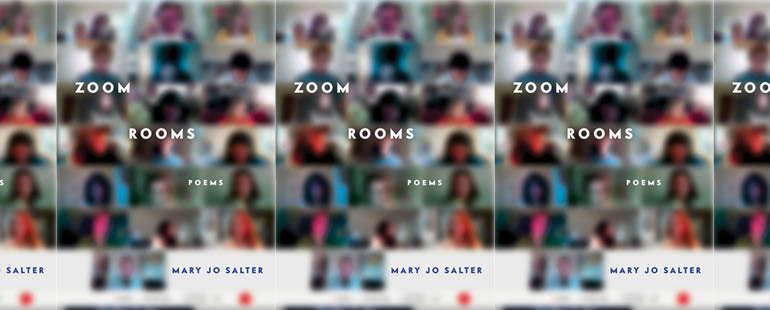Facing Pandemic Memories in Mary Jo Salter’s Zoom Rooms

Zoom Rooms
Mary Jo Salter
Knopf | March 29, 2022
In a world where we’ve grown so used to distance, how do we bridge the gap between ourselves and others? Mary Jo Salter’s latest collection of poetry, Zoom Rooms, reflects not only on a world forever changed by COVID-19, but also by the various ways experience has been compartmentalized—whether through the rectangle of a painted canvas or the squares that populate a Zoom meeting.
The poetic forms present in Salter’s collection emphasize this compartmentalization, as living in virtual rooms has become our mode of gathering for the past couple years. The second and fourth parts are each comprised of a single poem of linked sonnets. A compact poetic form composed of a single stanza, the sonnet visually creates “rooms” of meaning. I’m reminded of the definition Edward Hirsch gives for stanza in his A Poet’s Glossary: “The word stanza means ‘room’ in Italian—‘a station,’ ‘a stopping place,’—and each stanza in a poem is like a room in a house, a lyric dwelling place.” And yet, as the opening poem of the collection, “Your Session Has Timed Out,” reminds us, the connotations around our language are significantly affected by the current cultural moment:
In fact, the very terms
you use will soon be moot,
will take their downward spiral
like you to a black hole
while brave new worlds go viral—
assuming being “active”
or “inactive” is a thing
in the future. Or to “live.”
This theme is furthered in “Zoom Rooms,” the title poem that appears in part two. And here, it’s not merely our words that have been affected, but our very concept of self: “Self-surveilled, your eye contact on-screen / seems off. Don’t look at people! Focus where / the tiny camera is that proves you’re there.” Within this sonnet cycle, the speaker reflects not only on interactions with students in the transition to online classes, but with a new granddaughter born just before the pandemic that the speaker has had to watch grow up virtually:
…Am I in the room or
am I not? To find out, Leena leans
forward to try to taste my virtual head
and failing at that, lifts a lightbulb-screwing
sort of wave, a wrist-twist like a queen’s.
Real life at a social distance, almost dead,
what on earth can she think we think we’re doing?
The “almost dead” thread is picked up in another “room” of the sonnet cycle, where the speaker reflects on the strangeness of a virtual memorial service for a friend: “Shocking you died (of ‘something else’), and even / stranger you’re more present in our grief: / more three-dimensional than we are now.” The sonnet form renders each of these COVID-19 experiences distinct and mirrors the physical separation we have all had to endure.
In the same way, the use of haiku in poems like “Italian Haiku” and “Hat Day” juxtaposes freer pre-COVID-19 days—following a trip to Italy and a college memory, respectively—expressed in sparse words against the longer lines of the COVID-oriented sonnets. The result is an increased longing for a return to whatever “normal” means, alongside a realization that once life has changed, one cannot return to what life was like before. What’s more, we may not even really remember what came before. As the speaker says at the end of “Hat Day”:
Surely it happened,
but the truth is I can’t call
up Hat Day at all—I’ve had to invent
the whole memory, half a
century later.
The poems in this collection invite readers to consider what we will remember from a time that feels unforgettable now. As COVID-19 begins to take up less and less space in our heads, will it be more than distant memory, something almost unintelligible to future generations? The ekphrastic poems in this collection offer a canvas that, like the stanza, offers a window onto a moment frozen in time, a moment thought important enough to capture, to pass along to future generations.
In “St. Sebastian Interceding for the Plague-Stricken,” for example, the speaker describes a late fifteenth-century painting of an earlier pandemic. In light of 2020, the sickening and dying of the people in the scene perhaps has more resonance than ever before: a man in the act of tending to the sick “is pictured in the instant / he himself is stricken: / arms raised in agony,” while “the pint-sized saint” stands by and “prays but feels no pain.” Our time and place, our experiences, and our outlook on life all influence how we see, what we remember, and what we forget.
The final poem, “A Letter to Leena,” is as much a love poem to memory as it is a gift to a future generation for whom the speaker wonders, “Is it too much to hope, though, / you’ll get a whole life in?” Though the world seems in these days on the brink of destruction, it is again the stanzas on the page that give shape to little rooms—this time of interconnectedness and of hope—spaces in which a future Leena can find rest:
…choose to be glad
to change, not to wait and see.
I’m changed by you already.
I want to be around
more keenly than before,to live because you’re living.
In unfolding the many small moments that make up a life, Zoom Rooms offers readers not only resonance with its memories of the pandemic but an invitation to not take one’s memories for granted. Mary Jo Salter’s use of poetic forms and her characteristic surprising line breaks infuses her work with an element of play. For all that must be endured in an individual life and in the world, there is still beauty, goodness, and hope to be found.


